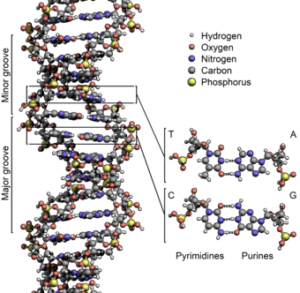 DNA
DNA 
|
The structure of the DNA double helix. The atoms in the structure are color-coded by element and the detailed structure of two base pairs are shown in the bottom right. |
Deoxyribonucleic acid (DNA) is a molecule that encodes the genetic instructions used in the development and functioning of all known living organisms, and many viruses. Along with RNA and proteins, DNA is one of the three major macromolecules essential for all known forms of life. Genetic information is encoded as a sequence of nucleotides (guanine, adenine, thymine, and cytosine), recorded using the letters G, A, T, and C. Most DNA molecules are double-stranded helices, consisting of two long polymers of simple units called nucleotides, molecules with backbones made of alternating sugars (deoxyribose), and phosphate groups (related to phosphoric acid), with the nucleobases (G, A, T, C) attached to the sugars. DNA is well-suited for biological information storage, since the DNA backbone is resistant to cleavage, and the double-stranded structure provides the molecule with a built-in duplicate of the encoded information. 
These two strands run in opposite directions to each other and are therefore anti-parallel, one backbone being 3′ (three prime), and the other being 5′ (five prime). This refers to the direction that the 3rd and 5th carbon on the sugar molecule is facing. Attached to each sugar is one of four types of molecules called nucleobases (informally, bases). It is the sequence of these four nucleobases along the backbone that encodes information. This information is read using the genetic code, which specifies the sequence of the amino acids within proteins. The code is read by copying stretches of DNA into the related nucleic acid RNA in a process called transcription. 
 Within cells, DNA is organized into long structures called chromosomes. During cell division these chromosomes are duplicated in the process of DNA replication, providing each cell its own complete set of chromosomes. Eukaryotic organisms (animals, plants, fungi, and protists) store most of their DNA inside the cell nucleus, and some of their DNA in organelles, such as mitochondria or chloroplasts. In contrast, prokaryotes (bacteria and archaea) store their DNA only in the cytoplasm. Within the chromosomes, chromatin proteins such as histones compact and organize DNA. These compact structures guide the interactions between DNA and other proteins, helping control which parts of the DNA are transcribed.
Within cells, DNA is organized into long structures called chromosomes. During cell division these chromosomes are duplicated in the process of DNA replication, providing each cell its own complete set of chromosomes. Eukaryotic organisms (animals, plants, fungi, and protists) store most of their DNA inside the cell nucleus, and some of their DNA in organelles, such as mitochondria or chloroplasts. In contrast, prokaryotes (bacteria and archaea) store their DNA only in the cytoplasm. Within the chromosomes, chromatin proteins such as histones compact and organize DNA. These compact structures guide the interactions between DNA and other proteins, helping control which parts of the DNA are transcribed. 
1. DNA is a molecule that encodes genetic instructions for:
a) mostly animals
b) mostly plants
c) all known living organisms
2. An example of a nucleotide is:
a) thymine
b) thyroid
c) guano
3. DNA is important for:
a) building a strong backbone
b) biological information storage
c) producing sugar for the body
4. The long DNA strands are called:
a) Eukaryotic organisms
b) chromosomes
c) organelles
5. Our genetic code is:
a) what determines our individual traits
b) helps us learn to code on the computer
c) difficult to break
6. How many strands make up a DNA double helix?
a) 2
b) 3
c) 5





















